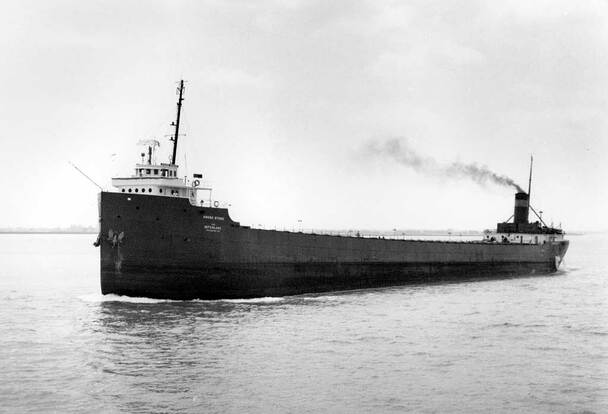Remembering Historic Carrier Amasa Stone
By James Donahue
Named for an American industrialist linked to tragedy, the Great Lakes steamship Amasa Stone served 55 successful years hauling grain, ore, coal and other goods between Duluth, Chicago and Buffalo. Her stripped-down hull continues to serve as a breakwater at the entrance to Charlevoix, Michigan, on the Lake Michigan coast.
The Stone was built by Detroit Ship Building Co. at Wyandotte and launched for the Mesaba Steamship Co. in 1905. It was named for Amasha Stone, 1818-1883, who built railroads and invested in mills and education. Stone committed suicide after a railroad bridge he helped design collapsed over the Ashtabula River, carrying 159 passengers and railroad workers to their deaths in 1876.
The steamer was about as large as commercial carriers came in her day, measuring 545 feet in length.
The Amasha Stone was put in service as an ore carrier in May, 1905, and was perhaps on the final leg of one of its first trips to Lake Superior ports and back to Cleveland, when she collided with and sank the up-bound steamer Etruria on June 18, 1905.
The collision occurred in dense fog in Lake Huron, about ten miles off Presque Isle at about 3:45 a.m. The Stone was laden with 10,000 tons of ore while the Etruria was traveling north with a cargo of 7,000 tons of coal, bound for Lake Michigan. Visibility was down to about 500 feet, so the crews did not see one another until it was too late. The Etruria was struck on the starboard side.
Because it was early in the morning, most of the crew members on the Etruria were asleep in their bunks. Even though the steamer sank within minutes, everybody escaped, although nobody saved any personal effects.
It was a dark blot on the Stone’s record, but not an omen of things to come.
Another major event involving the Stone occurred on the night of October 22, 1929, when the steamer survived a serious storm on Lake Michigan that sank the car ferry Milwaukee. She was laden with coal when she battled the storm off Ludington, Michigan.
The Stone was steaming through heavy seas on Lake Erie, off Dunkirk, New York, on July 29, 1930, when she successfully rescued six of the 21 crew members of the capsized sand sucker George J. Whelan.
The Stone went through at least two major refitting, having her boilers replaced in 1938 and new diesel engines installed in 1952. But the old boat’s days were numbered. She sailed for her last season in 1959 before being laid up never to sail again.
She was sold in 1965 to the Medusa Portland Cement Co. of Charlevoix, stripped down to the hull and used to build a dock and breakwall. She rests there today alongside another historic ship, the Charles S. Hebard.
By James Donahue
Named for an American industrialist linked to tragedy, the Great Lakes steamship Amasa Stone served 55 successful years hauling grain, ore, coal and other goods between Duluth, Chicago and Buffalo. Her stripped-down hull continues to serve as a breakwater at the entrance to Charlevoix, Michigan, on the Lake Michigan coast.
The Stone was built by Detroit Ship Building Co. at Wyandotte and launched for the Mesaba Steamship Co. in 1905. It was named for Amasha Stone, 1818-1883, who built railroads and invested in mills and education. Stone committed suicide after a railroad bridge he helped design collapsed over the Ashtabula River, carrying 159 passengers and railroad workers to their deaths in 1876.
The steamer was about as large as commercial carriers came in her day, measuring 545 feet in length.
The Amasha Stone was put in service as an ore carrier in May, 1905, and was perhaps on the final leg of one of its first trips to Lake Superior ports and back to Cleveland, when she collided with and sank the up-bound steamer Etruria on June 18, 1905.
The collision occurred in dense fog in Lake Huron, about ten miles off Presque Isle at about 3:45 a.m. The Stone was laden with 10,000 tons of ore while the Etruria was traveling north with a cargo of 7,000 tons of coal, bound for Lake Michigan. Visibility was down to about 500 feet, so the crews did not see one another until it was too late. The Etruria was struck on the starboard side.
Because it was early in the morning, most of the crew members on the Etruria were asleep in their bunks. Even though the steamer sank within minutes, everybody escaped, although nobody saved any personal effects.
It was a dark blot on the Stone’s record, but not an omen of things to come.
Another major event involving the Stone occurred on the night of October 22, 1929, when the steamer survived a serious storm on Lake Michigan that sank the car ferry Milwaukee. She was laden with coal when she battled the storm off Ludington, Michigan.
The Stone was steaming through heavy seas on Lake Erie, off Dunkirk, New York, on July 29, 1930, when she successfully rescued six of the 21 crew members of the capsized sand sucker George J. Whelan.
The Stone went through at least two major refitting, having her boilers replaced in 1938 and new diesel engines installed in 1952. But the old boat’s days were numbered. She sailed for her last season in 1959 before being laid up never to sail again.
She was sold in 1965 to the Medusa Portland Cement Co. of Charlevoix, stripped down to the hull and used to build a dock and breakwall. She rests there today alongside another historic ship, the Charles S. Hebard.
